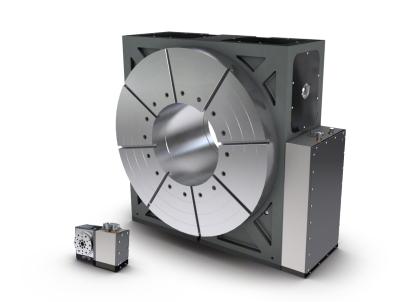
Rotary tables are ideal for machining multiple sides of a part in a single setup or for machining many parts on a multiple-sided fixture. But handling very large or very small parts can prove challenging without the correct size rotary. The HRT1000 and HRT100 rotary tables from Haas Automation Inc. cover both ends of the size spectrum, providing high-precision 4th-axis positioning and simultaneous 4-axis motion for extra-large and extra-small parts.
Whether you’re machining large shafts for windmills, rethreading drill pipe or machining blowout preventers, the extra-large Haas HRT1000 rotary table has what you need to handle the big jobs. With its massive platter, generous torque and large through-hole, this extra-large rotary table will easily handle even the biggest 4-axis jobs in your shop.
The HRT1000 rotary table is one of three brand-new, extra-large rotary tables from Haas. It features a massive 1000 mm (39.37") T-slot platter, with a 17.50" (445 mm) through-hole to handle large shafts and fixtures. The HRT1000 provides 2000 ft-lb (2711 Nm) of cutting torque for simultaneous 4-axis machining, and offers 14,000 ft-lb (18,981 Nm) of brake torque to accommodate large parts and heavy off-center milling and drilling. The platter has 8 standard 5/8" (16 mm) T-slots arranged radially at 45 degree increments.
At the other end of the scale, the ultracompact HRT100 rotary table provides high-speed, accurate positioning and full 4-axis motion for machining small parts, such as those found in the medical, dental and electronics industries. Designed to complement the diminutive Haas CM-1 Compact Mill, the unit’s very small size and light weight make it a suitable 4-axis solution for even the smallest machining centers.
The HRT100 provides 35 ft-lb (47 Nm) of cutting torque, and the 100 mm (3.94") platter indexes at 300 deg/sec for short cycle times. The platter has multiple bolt-hole patterns for flexible fixture mounting, and the table provides 26 ft-lb (35 Nm) of brake torque to handle off-center milling and drilling.
Contact Details
Related Glossary Terms
- centers
centers
Cone-shaped pins that support a workpiece by one or two ends during machining. The centers fit into holes drilled in the workpiece ends. Centers that turn with the workpiece are called “live” centers; those that do not are called “dead” centers.
- fixture
fixture
Device, often made in-house, that holds a specific workpiece. See jig; modular fixturing.
- gang cutting ( milling)
gang cutting ( milling)
Machining with several cutters mounted on a single arbor, generally for simultaneous cutting.
- milling
milling
Machining operation in which metal or other material is removed by applying power to a rotating cutter. In vertical milling, the cutting tool is mounted vertically on the spindle. In horizontal milling, the cutting tool is mounted horizontally, either directly on the spindle or on an arbor. Horizontal milling is further broken down into conventional milling, where the cutter rotates opposite the direction of feed, or “up” into the workpiece; and climb milling, where the cutter rotates in the direction of feed, or “down” into the workpiece. Milling operations include plane or surface milling, endmilling, facemilling, angle milling, form milling and profiling.
- milling machine ( mill)
milling machine ( mill)
Runs endmills and arbor-mounted milling cutters. Features include a head with a spindle that drives the cutters; a column, knee and table that provide motion in the three Cartesian axes; and a base that supports the components and houses the cutting-fluid pump and reservoir. The work is mounted on the table and fed into the rotating cutter or endmill to accomplish the milling steps; vertical milling machines also feed endmills into the work by means of a spindle-mounted quill. Models range from small manual machines to big bed-type and duplex mills. All take one of three basic forms: vertical, horizontal or convertible horizontal/vertical. Vertical machines may be knee-type (the table is mounted on a knee that can be elevated) or bed-type (the table is securely supported and only moves horizontally). In general, horizontal machines are bigger and more powerful, while vertical machines are lighter but more versatile and easier to set up and operate.
- through-hole
through-hole
Hole or cavity cut in a solid shape that connects with other holes or extends all the way through the workpiece.
